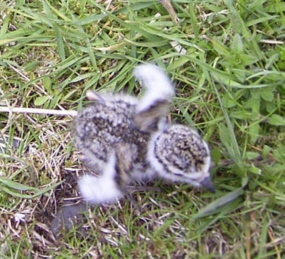- Charadrius hiaticula
Identification
This is one of our most delightful waders. A small bird (17-19.5 cm body length) with a distinctive bold black and white pattern on the head, short orange bill with black tip and orange legs. The grey-brown upperparts blend well with a variety of shingle and sand colours, so that a sitting bird is often unnoticed.
In winter, the legs usually becomes a little duller, the bill becomes mostly or all black, and the black in head and neck markings becomes browner and less distinct.
Immatures are similar but with many feathers having white edgings giving a scaly impression.
Similar species
Semipalmated Plover is closest, Little Ringed Plover the more common similar species in Europe
Distribution

Almost worldwide: breeding from north-east Canada and Greenland to Europe (mostly northern half) and Asia, wintering in southern Europe, Africa, and southern Asia. Vagrant to southern Canada, USA, and the Caribbean.
Fortunately, this beautiful bird is widespread in Britain and Europe and can be found all year round in Britain.
The British Trust for Ornithology carried out a special survey of this species (and the Little Ringed Plover) in 2007 - 20 years after the last detailed UK -wide survey.
Taxonomy
Subspecies
There are 2 subspecies1
- C. h. hiaticula - north-eastern Canada and Greenland to Scandinavia; winters to Africa
- C. h. tundrae - Russia and Siberia; winters Caspian Sea, south-western Asia to South Africa
- C. h. psammodromus - Not recognized by all authorities.
Habitat

Mostly seen at the coast, but also found inland, wherever there is water e.g. gravel pits, reservoirs and in tundra.
Behaviour
Ringed Plover can be almost impossible to see with the naked eye when on shingle beaches - one of its favourite habitats. Its movement, flight or plaintive call almost always reveal its presence, however. At sites where there is regular human traffic, one can get within 10-15 m of birds without too much difficulty - but still need optics to see them!
Diet
The short bill is used to forage along the low water mark and amongst pebbles and drift seaweed. Sand hoppers and insects are favoured prey.
Breeding
The eggs are laid in a depression with no nest material at all, often just above the strandline, and may be inundated by exceptionally high tides. One parent sits on the nest while the other forages nearby. Disturbed birds will wait until they feel safe, then one will run up the shore to the nest.
Once hatched, the chicks are soon on the move, exploring their surroundings (see images of 2 ringed chicks). When danger threatens, a call from a parent causes them to freeze and sit tight until the parent calls the 'all clear'. Chicks are brooded beneath parents when conditions are cold or wet, but are left to find their own food. Like other wader chicks, their legs and feet appear oversized compared with the body and it takes several weeks before their proportions resemble those of the adult.
Adults will defend the young against predators 3-4 times their size e.g. Herring Gulls.
Vocalisation
<flashmp3>Charadrius hiaticula (song).mp3</flashmp3>
Listen in an external program
References
- Clements, JF. 2010. The Clements Checklist of Birds of the World. 6th ed., with updates to December 2010. Ithaca: Cornell Univ. Press. ISBN 978-0801445019. Spreadsheet available at http://www.birds.cornell.edu/clementschecklist/Clements%206.5.xls/view
Recommended Citation
- BirdForum Opus contributors. (2024) Common Ringed Plover. In: BirdForum, the forum for wild birds and birding. Retrieved 2 May 2024 from https://www.birdforum.net/opus/Common_Ringed_Plover
External Links





